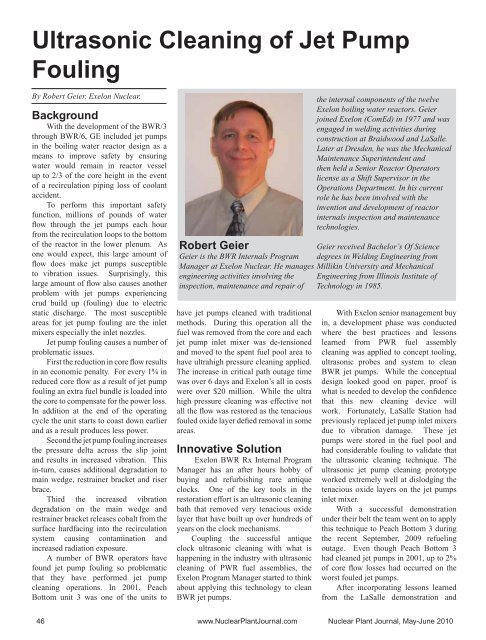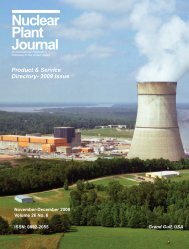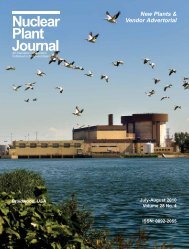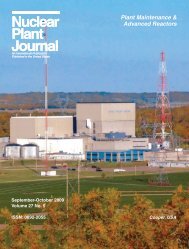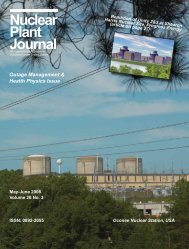New Energy - Digital Versions - Nuclear Plant Journal
New Energy - Digital Versions - Nuclear Plant Journal
New Energy - Digital Versions - Nuclear Plant Journal
You also want an ePaper? Increase the reach of your titles
YUMPU automatically turns print PDFs into web optimized ePapers that Google loves.
Ultrasonic Cleaning of Jet Pump<br />
Fouling<br />
By Robert Geier, Exelon <strong>Nuclear</strong>.<br />
Background<br />
With the development of the BWR/3<br />
through BWR/6, GE included jet pumps<br />
in the boiling water reactor design as a<br />
means to improve safety by ensuring<br />
water would remain in reactor vessel<br />
up to 2/3 of the core height in the event<br />
of a recirculation piping loss of coolant<br />
accident.<br />
To perform this important safety<br />
function, millions of pounds of water<br />
flow through the jet pumps each hour<br />
from the recirculation loops to the bottom<br />
of the reactor in the lower plenum. As<br />
one would expect, this large amount of<br />
flow does make jet pumps susceptible<br />
to vibration issues. Surprisingly, this<br />
large amount of flow also causes another<br />
problem with jet pumps experiencing<br />
crud build up (fouling) due to electric<br />
static discharge. The most susceptible<br />
areas for jet pump fouling are the inlet<br />
mixers especially the inlet nozzles.<br />
Jet pump fouling causes a number of<br />
problematic issues.<br />
First the reduction in core flow results<br />
in an economic penalty. For every 1% in<br />
reduced core flow as a result of jet pump<br />
fouling an extra fuel bundle is loaded into<br />
the core to compensate for the power loss.<br />
In addition at the end of the operating<br />
cycle the unit starts to coast down earlier<br />
and as a result produces less power.<br />
Second the jet pump fouling increases<br />
the pressure delta across the slip joint<br />
and results in increased vibration. This<br />
in-turn, causes additional degradation to<br />
main wedge, restrainer bracket and riser<br />
brace.<br />
Third the increased vibration<br />
degradation on the main wedge and<br />
restrainer bracket releases cobalt from the<br />
surface hardfacing into the recirculation<br />
system causing contamination and<br />
increased radiation exposure.<br />
A number of BWR operators have<br />
found jet pump fouling so problematic<br />
that they have performed jet pump<br />
cleaning operations. In 2001, Peach<br />
Bottom unit 3 was one of the units to<br />
Robert Geier<br />
Geier is the BWR Internals Program<br />
Manager at Exelon <strong>Nuclear</strong>. He manages<br />
engineering activities involving the<br />
inspection, maintenance and repair of<br />
have jet pumps cleaned with traditional<br />
methods. During this operation all the<br />
fuel was removed from the core and each<br />
jet pump inlet mixer was de-tensioned<br />
and moved to the spent fuel pool area to<br />
have ultrahigh pressure cleaning applied.<br />
The increase in critical path outage time<br />
was over 6 days and Exelon’s all in costs<br />
were over $20 million. While the ultra<br />
high pressure cleaning was effective not<br />
all the flow was restored as the tenacious<br />
fouled oxide layer defied removal in some<br />
areas.<br />
Innovative Solution<br />
Exelon BWR Rx Internal Program<br />
Manager has an after hours hobby of<br />
buying and refurbishing rare antique<br />
clocks. One of the key tools in the<br />
restoration effort is an ultrasonic cleaning<br />
bath that removed very tenacious oxide<br />
layer that have built up over hundreds of<br />
years on the clock mechanisms.<br />
Coupling the successful antique<br />
clock ultrasonic cleaning with what is<br />
happening in the industry with ultrasonic<br />
cleaning of PWR fuel assemblies, the<br />
Exelon Program Manager started to think<br />
about applying this technology to clean<br />
BWR jet pumps.<br />
the internal components of the twelve<br />
Exelon boiling water reactors. Geier<br />
joined Exelon (ComEd) in 1977 and was<br />
engaged in welding activities during<br />
construction at Braidwood and LaSalle.<br />
Later at Dresden, he was the Mechanical<br />
Maintenance Superintendent and<br />
then held (Continued a Senior Reactor on page Operators 47)<br />
license as a Shift Supervisor in the<br />
Operations Department. In his current<br />
role he has been involved with the<br />
invention and development of reactor<br />
internals inspection and maintenance<br />
technologies.<br />
Geier received Bachelor’s Of Science<br />
degrees in Welding Engineering from<br />
Millikin University and Mechanical<br />
Engineering from Illinois Institute of<br />
Technology in 1985.<br />
With Exelon senior management buy<br />
in, a development phase was conducted<br />
where the best practices and lessons<br />
learned from PWR fuel assembly<br />
cleaning was applied to concept tooling,<br />
ultrasonic probes and system to clean<br />
BWR jet pumps. While the conceptual<br />
design looked good on paper, proof is<br />
what is needed to develop the confidence<br />
that this new cleaning device will<br />
work. Fortunately, LaSalle Station had<br />
previously replaced jet pump inlet mixers<br />
due to vibration damage. These jet<br />
pumps were stored in the fuel pool and<br />
had considerable fouling to validate that<br />
the ultrasonic cleaning technique. The<br />
ultrasonic jet pump cleaning prototype<br />
worked extremely well at dislodging the<br />
tenacious oxide layers on the jet pumps<br />
inlet mixer.<br />
With a successful demonstration<br />
under their belt the team went on to apply<br />
this technique to Peach Bottom 3 during<br />
the recent September, 2009 refueling<br />
outage. Even though Peach Bottom 3<br />
had cleaned jet pumps in 2001, up to 2%<br />
of core flow losses had occurred on the<br />
worst fouled jet pumps.<br />
After incorporating lessons learned<br />
from the LaSalle demonstration and<br />
46 www.<strong>Nuclear</strong><strong>Plant</strong><strong>Journal</strong>.com <strong>Nuclear</strong> <strong>Plant</strong> <strong>Journal</strong>, May-June 2010


